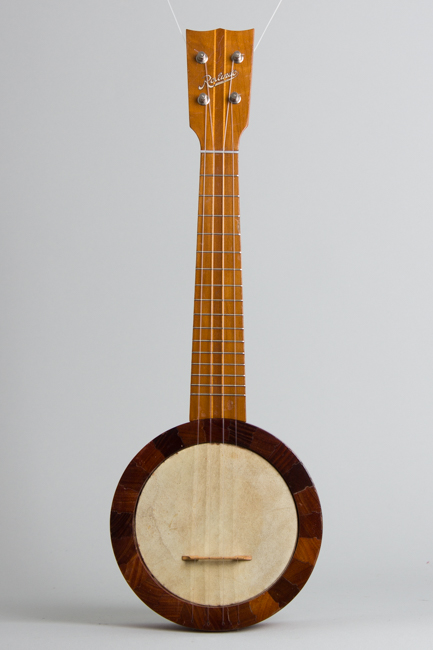Rolando California Style Banjo Ukulele , c. 1920
This item has been sold.
Item # 11593
Prices subject to change without notice.
Rolando California Style Model Banjo Ukulele, c. 1920, made in Los Angeles, California, natural varnish finish, varied multiple laminated wood construction, brown hard shell case.
This is a nice example of the large and varied family of mostly simple integral-rim banjo ukes labeled "California-style" in the catalogs of the day. With a rim made of lock-jointed wooden blocks and the head tightened from inside this was a very low-cost design to manufacture. They were sold everywhere in huge numbers and played a large part in helping to launch the ukulele craze of the 1920s. Innumerable variations were made by the thousands in the late 1910s and early '20s with varying colors, finishes, and decorations. This one was actually sold (and probably made) in California, as it bears the "Rolando" trade name that belonged the Southern California Music Company who briefly applied it in the late 1910s to koa wood Martin guitars.
This little 100+ year old gem is fairly plain but neatly made with a rim made of blocks of contrasting wood and a flat plate resonator suspended over the back. The light-finished neck has no inlay but is made up of several contrasting strips of natural-finished wood, a long time before Alembic used this look in the 1970s! The tuners are recent friction pegs but all else appears of the period. The instrument plays well and the sound is punchy but sweeter and mellower than more banjo-like banjoleles, sort of halfway to a wooden soprano uke. This is an unassuming but cool survivor about a century along, still fun to play and a great tagalong instrument to take anywhere.
Overall length is 20 in. (50.8 cm.), 5 1/2 in. (14 cm.) diameter head, and 3 5/8 in. (9.2 cm.) in depth, measured at side of rim. Scale length is 13 in. (330 mm.). Width of nut is 1 1/4 in. (32 mm.).
Thus uke shows light general wear but for being about 100 years old is looking good, and is fully playable. The finish has some general wear and tear, with small dings, dents and scrapes and moisture damage to the finish on the resonator. There are a couple neatly resealed seams in the rim and two visible sealed cracks across the back of the resonator. None are causing any ongoing issues. The tuning pegs are more recent but all else appears original. The instrument plays very well and its plunky cheerful sound is an instant trip back to the early 1920s. Overall Excellent - Condition.
This is a nice example of the large and varied family of mostly simple integral-rim banjo ukes labeled "California-style" in the catalogs of the day. With a rim made of lock-jointed wooden blocks and the head tightened from inside this was a very low-cost design to manufacture. They were sold everywhere in huge numbers and played a large part in helping to launch the ukulele craze of the 1920s. Innumerable variations were made by the thousands in the late 1910s and early '20s with varying colors, finishes, and decorations. This one was actually sold (and probably made) in California, as it bears the "Rolando" trade name that belonged the Southern California Music Company who briefly applied it in the late 1910s to koa wood Martin guitars.
This little 100+ year old gem is fairly plain but neatly made with a rim made of blocks of contrasting wood and a flat plate resonator suspended over the back. The light-finished neck has no inlay but is made up of several contrasting strips of natural-finished wood, a long time before Alembic used this look in the 1970s! The tuners are recent friction pegs but all else appears of the period. The instrument plays well and the sound is punchy but sweeter and mellower than more banjo-like banjoleles, sort of halfway to a wooden soprano uke. This is an unassuming but cool survivor about a century along, still fun to play and a great tagalong instrument to take anywhere.
Overall length is 20 in. (50.8 cm.), 5 1/2 in. (14 cm.) diameter head, and 3 5/8 in. (9.2 cm.) in depth, measured at side of rim. Scale length is 13 in. (330 mm.). Width of nut is 1 1/4 in. (32 mm.).
Thus uke shows light general wear but for being about 100 years old is looking good, and is fully playable. The finish has some general wear and tear, with small dings, dents and scrapes and moisture damage to the finish on the resonator. There are a couple neatly resealed seams in the rim and two visible sealed cracks across the back of the resonator. None are causing any ongoing issues. The tuning pegs are more recent but all else appears original. The instrument plays very well and its plunky cheerful sound is an instant trip back to the early 1920s. Overall Excellent - Condition.












